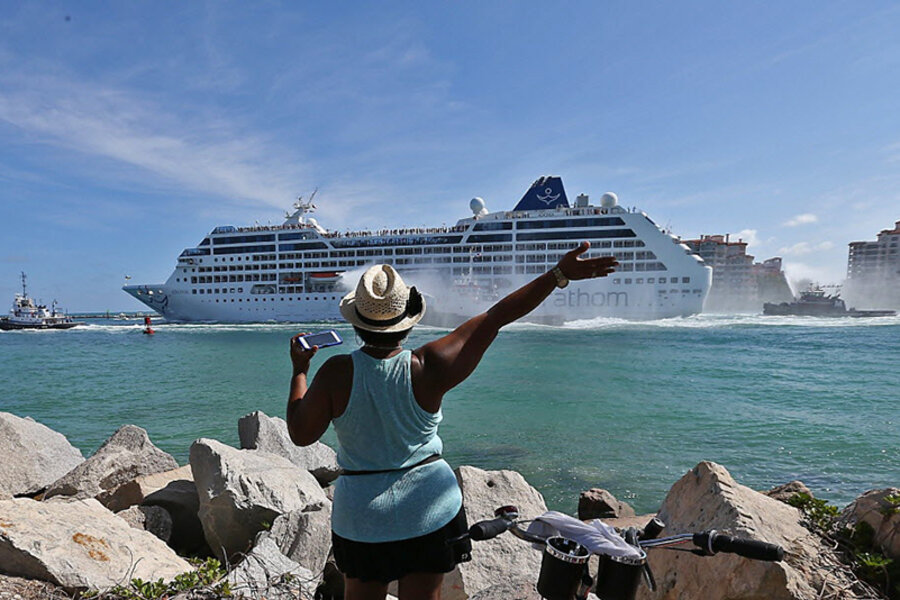First American cruise in more than 50 years heads for Cuba
Loading...
With a live band playing Cuban standards and some passengers carrying flags, the Fathom Adonia set sail from Miami on Sunday afternoon, poised to become the first American cruise ship to sail to Cuba in more than half a century.
"We're going to sail directly from the United States to Havana, Cuba," Captain David Box told passengers over the ship's PA system, the Sun-Sentinel reports. "How awesome is that? Tomorrow we will make history."
The voyage, on a 600-passenger ship run by Fathom, a "social impact" offshoot of cruise giant Carnival, was made possible by a growing thaw in US-Cuba relations, including less restrictions on commerce and for Cubans hoping to work in the US.
But the Adonia almost didn't make it out of port. A decades-old Cuban policy prohibited passengers born in Cuba traveling to Cuba by sea, a ban that would have affected the travel of several passengers onboard, including Arnie Pérez, Carnival’s chief legal counsel.
News of the ban sparked demonstrations outside Carnival's offices in Doral, Fla., with newspaper editorials questioning why the cruise company would accede to the decades-old ban.
"It is not OK for an American business to abide by policies that discriminate against Americans. It is not OK for an American business to check the birthplace on citizens' passports before letting them aboard," wrote the Sun-Sentinel's editorial board on April 12.
But on April 22, the Cuban government relented and lifted the ban, with the ship now carrying 10 to 25 Cuban-born passengers, the Miami Herald reports.
While US tourism to the island nation is still technically prohibited, Americans can travel to Cuba on an organized trip as long as it is an educational "person to person" experience that includes interactions with Cuban people.
But because the State Department has offered few guidelines on exactly what that entails, as the Associated Press notes, " 'educational travel' is so broad it can include virtually any activity that isn't lying on a beach drinking mojitos." In addition to Carnival's Fathom, other cruise lines have also been negotiating to include Cuba as a destination for American travelers.
Fathom, which has also offered a trip to the Dominican Republic where passengers can volunteer to plant trees, work in a chocolate cooperative, or pour cement floors, is offering programs in Cuban history, culture, and conversational Spanish onboard the Adonia.
The company will also offer tours intended to have passengers engage more fully in an exchange with local residents, the Sun-Sentinel reports.
While the activities aren't required, legally passengers will be required to keep a log of their "people to people" activities for five years in case they are asked to explain the trip, the AP reports.
For many passengers, the historic nature of the cruise, where tickets began at $2,662 a person, was a major draw.
"We said, 'This is for us,' " Francine Lacey, a retired school teacher sailing with seven of her friends from Philadelphia told the Sun Sentinel. "For 50 years I've wondered about Cuba, didn't understand our policy, and this was the chance."
The cruise will dock in Havana Monday morning, spending Monday and Tuesday there before making shorter stops in Cienfuegos and Santiago de Cuba. It will then return to Miami the following Sunday morning.
Before the ship departed, the Democracia, a boat owned by a Cuban-American group that opposes any travel to Cuba, appeared nearby. Several Miami Police boats kept the protesting boat yards away from the cruise ship, the Sun Sentinel reports.
Some people making the trip said they wanted to see Cuba for the first time or recreate family memories from when travel to the island was legal. Others expressed a desire to see the country before American businesses eventually expanded there and possibly changed its character.
"I want to get there before Starbucks does," Cynthia Slattum, of Melbourne, Fla. told the Herald.





